Project Management- Agile Project Management
VerifiedAdded on 2022/08/27
|11
|2354
|29
AI Summary
Contribute Materials
Your contribution can guide someone’s learning journey. Share your
documents today.
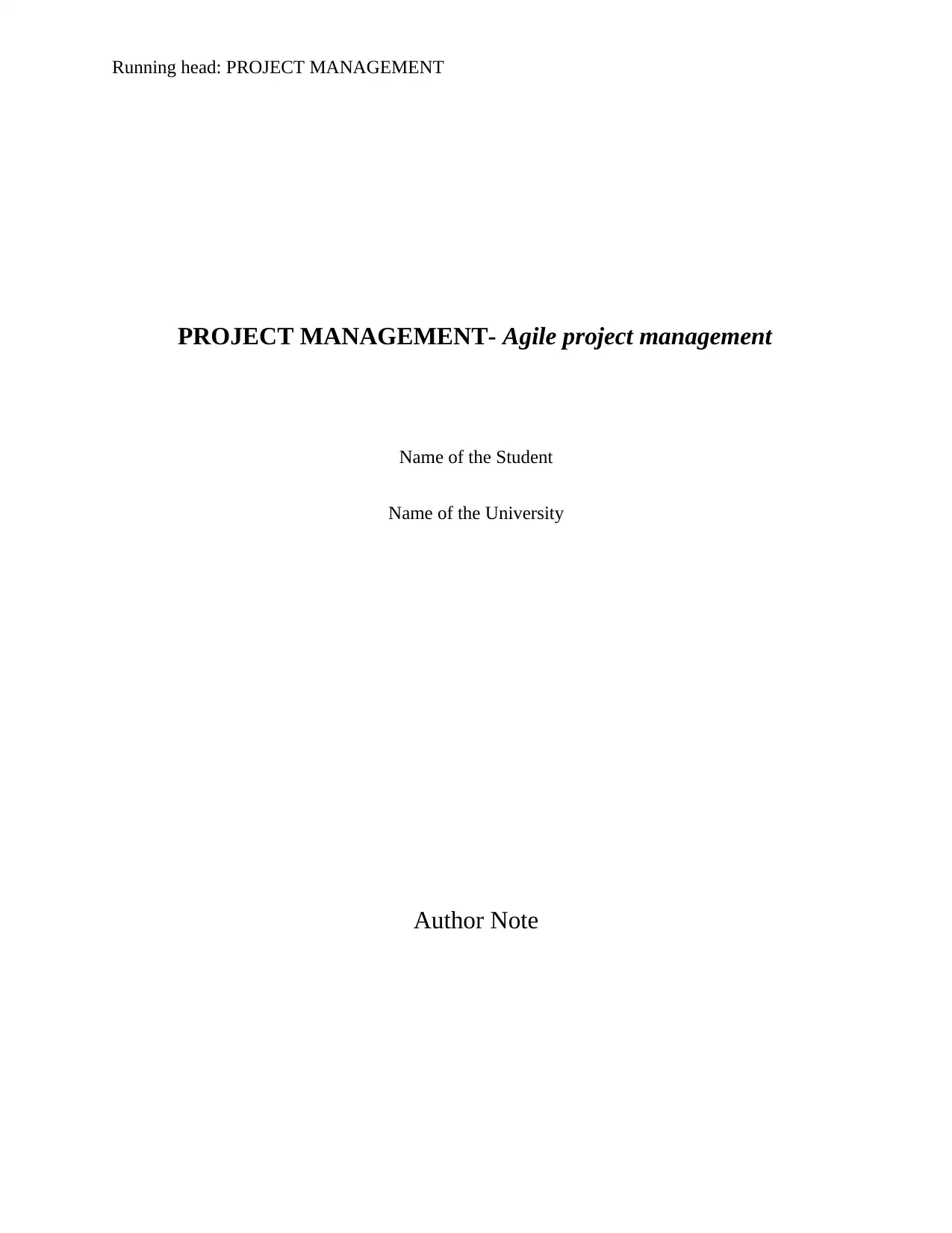
Running head: PROJECT MANAGEMENT
PROJECT MANAGEMENT- Agile project management
Name of the Student
Name of the University
Author Note
PROJECT MANAGEMENT- Agile project management
Name of the Student
Name of the University
Author Note
Secure Best Marks with AI Grader
Need help grading? Try our AI Grader for instant feedback on your assignments.
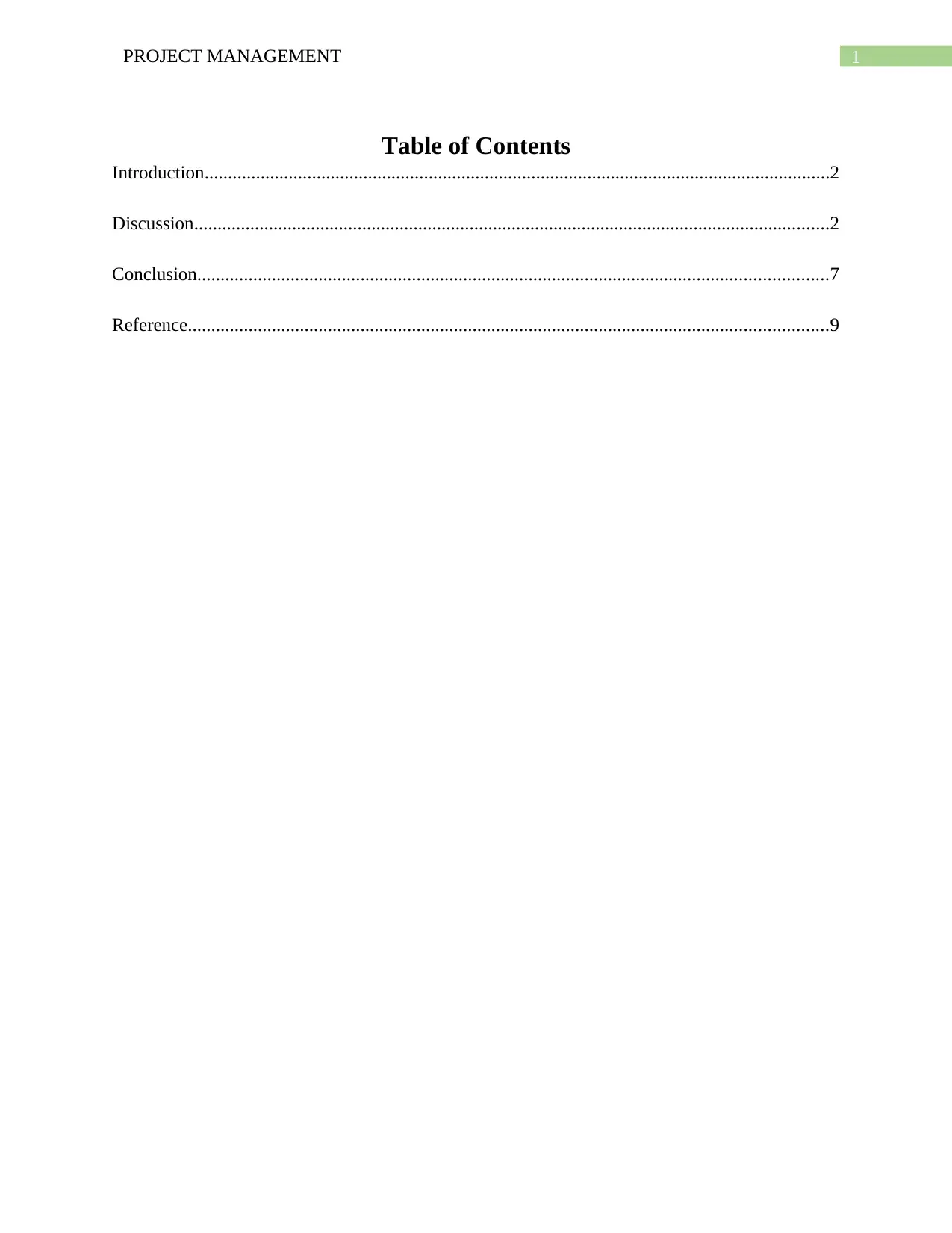
1PROJECT MANAGEMENT
Table of Contents
Introduction......................................................................................................................................2
Discussion........................................................................................................................................2
Conclusion.......................................................................................................................................7
Reference.........................................................................................................................................9
Table of Contents
Introduction......................................................................................................................................2
Discussion........................................................................................................................................2
Conclusion.......................................................................................................................................7
Reference.........................................................................................................................................9
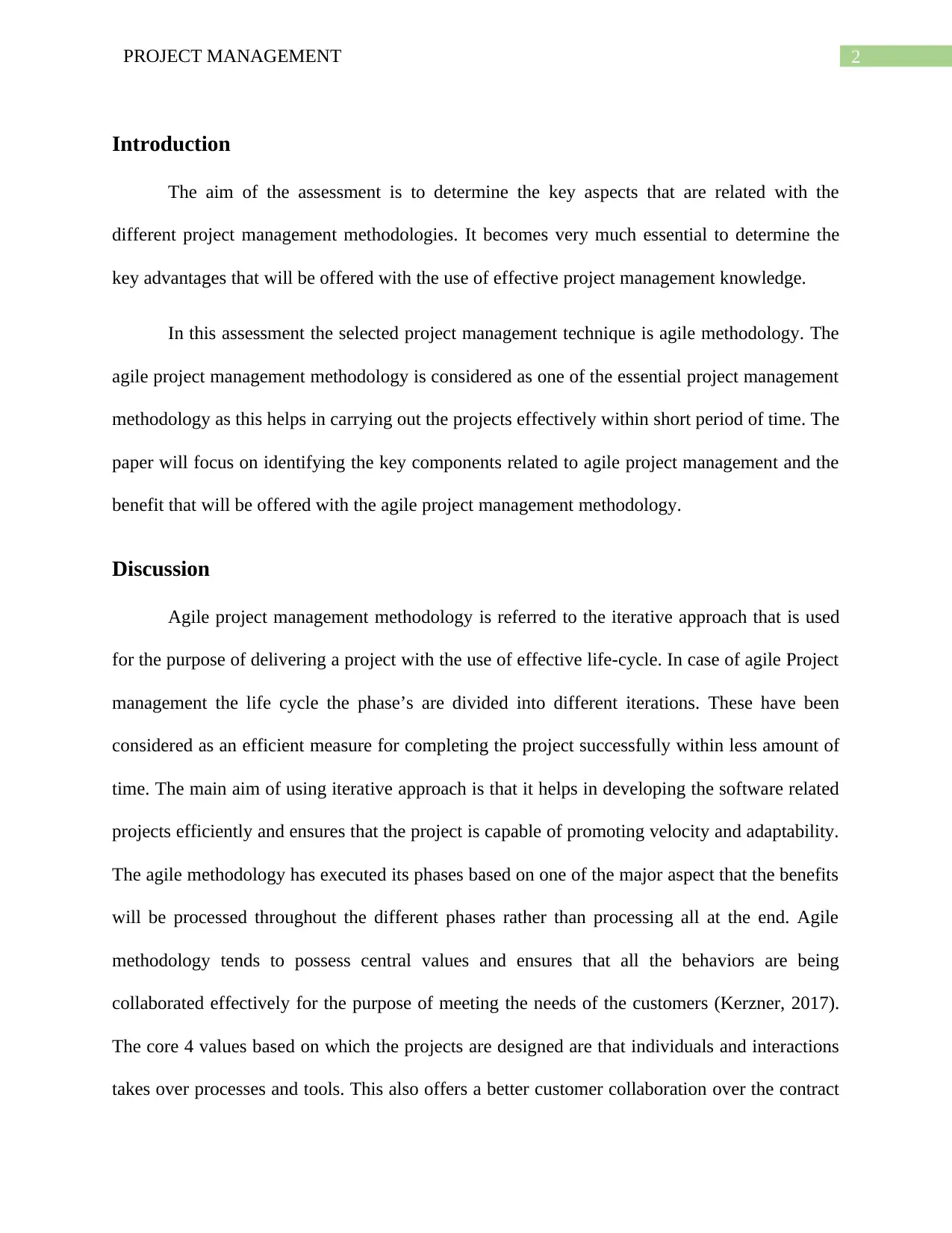
2PROJECT MANAGEMENT
Introduction
The aim of the assessment is to determine the key aspects that are related with the
different project management methodologies. It becomes very much essential to determine the
key advantages that will be offered with the use of effective project management knowledge.
In this assessment the selected project management technique is agile methodology. The
agile project management methodology is considered as one of the essential project management
methodology as this helps in carrying out the projects effectively within short period of time. The
paper will focus on identifying the key components related to agile project management and the
benefit that will be offered with the agile project management methodology.
Discussion
Agile project management methodology is referred to the iterative approach that is used
for the purpose of delivering a project with the use of effective life-cycle. In case of agile Project
management the life cycle the phase’s are divided into different iterations. These have been
considered as an efficient measure for completing the project successfully within less amount of
time. The main aim of using iterative approach is that it helps in developing the software related
projects efficiently and ensures that the project is capable of promoting velocity and adaptability.
The agile methodology has executed its phases based on one of the major aspect that the benefits
will be processed throughout the different phases rather than processing all at the end. Agile
methodology tends to possess central values and ensures that all the behaviors are being
collaborated effectively for the purpose of meeting the needs of the customers (Kerzner, 2017).
The core 4 values based on which the projects are designed are that individuals and interactions
takes over processes and tools. This also offers a better customer collaboration over the contract
Introduction
The aim of the assessment is to determine the key aspects that are related with the
different project management methodologies. It becomes very much essential to determine the
key advantages that will be offered with the use of effective project management knowledge.
In this assessment the selected project management technique is agile methodology. The
agile project management methodology is considered as one of the essential project management
methodology as this helps in carrying out the projects effectively within short period of time. The
paper will focus on identifying the key components related to agile project management and the
benefit that will be offered with the agile project management methodology.
Discussion
Agile project management methodology is referred to the iterative approach that is used
for the purpose of delivering a project with the use of effective life-cycle. In case of agile Project
management the life cycle the phase’s are divided into different iterations. These have been
considered as an efficient measure for completing the project successfully within less amount of
time. The main aim of using iterative approach is that it helps in developing the software related
projects efficiently and ensures that the project is capable of promoting velocity and adaptability.
The agile methodology has executed its phases based on one of the major aspect that the benefits
will be processed throughout the different phases rather than processing all at the end. Agile
methodology tends to possess central values and ensures that all the behaviors are being
collaborated effectively for the purpose of meeting the needs of the customers (Kerzner, 2017).
The core 4 values based on which the projects are designed are that individuals and interactions
takes over processes and tools. This also offers a better customer collaboration over the contract
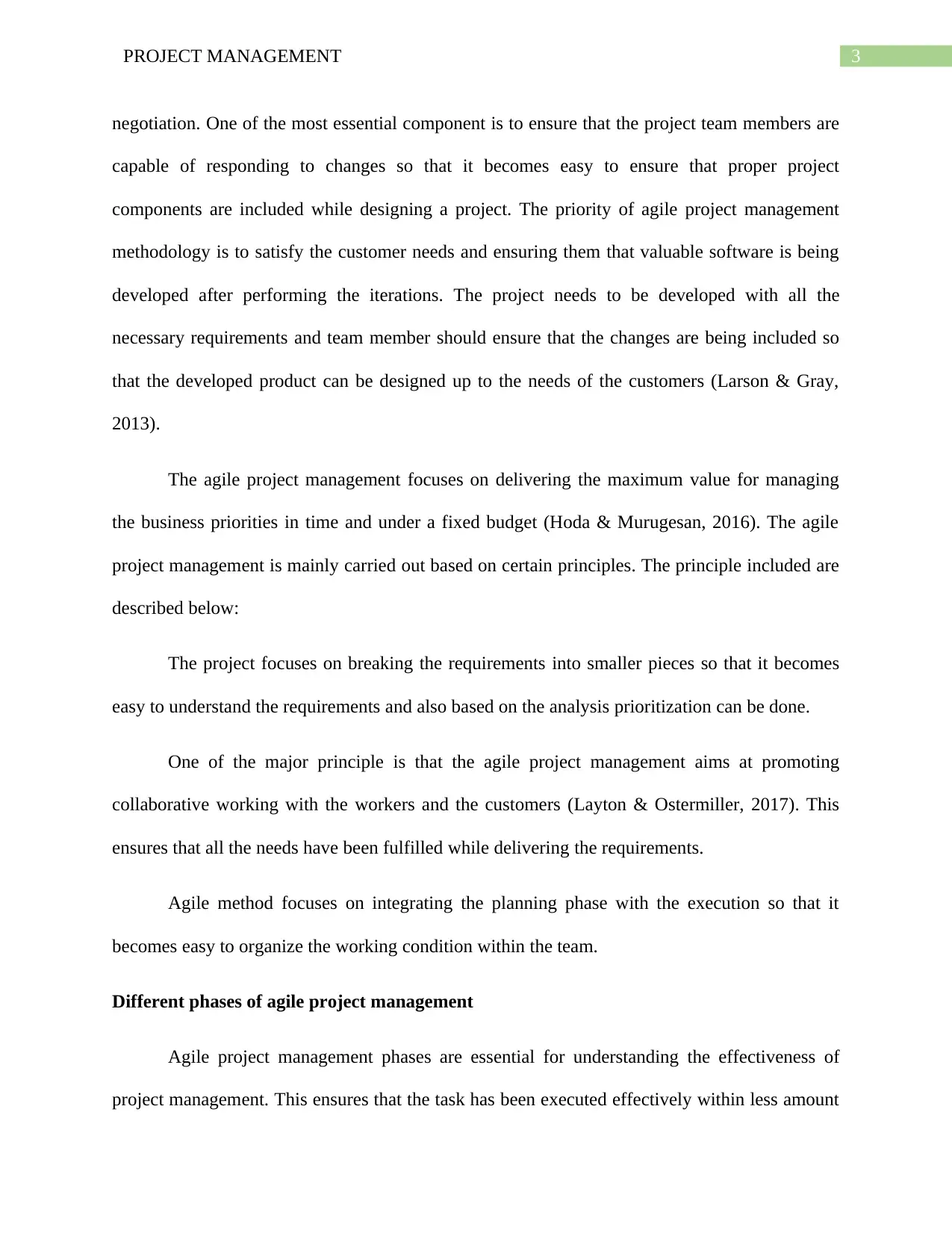
3PROJECT MANAGEMENT
negotiation. One of the most essential component is to ensure that the project team members are
capable of responding to changes so that it becomes easy to ensure that proper project
components are included while designing a project. The priority of agile project management
methodology is to satisfy the customer needs and ensuring them that valuable software is being
developed after performing the iterations. The project needs to be developed with all the
necessary requirements and team member should ensure that the changes are being included so
that the developed product can be designed up to the needs of the customers (Larson & Gray,
2013).
The agile project management focuses on delivering the maximum value for managing
the business priorities in time and under a fixed budget (Hoda & Murugesan, 2016). The agile
project management is mainly carried out based on certain principles. The principle included are
described below:
The project focuses on breaking the requirements into smaller pieces so that it becomes
easy to understand the requirements and also based on the analysis prioritization can be done.
One of the major principle is that the agile project management aims at promoting
collaborative working with the workers and the customers (Layton & Ostermiller, 2017). This
ensures that all the needs have been fulfilled while delivering the requirements.
Agile method focuses on integrating the planning phase with the execution so that it
becomes easy to organize the working condition within the team.
Different phases of agile project management
Agile project management phases are essential for understanding the effectiveness of
project management. This ensures that the task has been executed effectively within less amount
negotiation. One of the most essential component is to ensure that the project team members are
capable of responding to changes so that it becomes easy to ensure that proper project
components are included while designing a project. The priority of agile project management
methodology is to satisfy the customer needs and ensuring them that valuable software is being
developed after performing the iterations. The project needs to be developed with all the
necessary requirements and team member should ensure that the changes are being included so
that the developed product can be designed up to the needs of the customers (Larson & Gray,
2013).
The agile project management focuses on delivering the maximum value for managing
the business priorities in time and under a fixed budget (Hoda & Murugesan, 2016). The agile
project management is mainly carried out based on certain principles. The principle included are
described below:
The project focuses on breaking the requirements into smaller pieces so that it becomes
easy to understand the requirements and also based on the analysis prioritization can be done.
One of the major principle is that the agile project management aims at promoting
collaborative working with the workers and the customers (Layton & Ostermiller, 2017). This
ensures that all the needs have been fulfilled while delivering the requirements.
Agile method focuses on integrating the planning phase with the execution so that it
becomes easy to organize the working condition within the team.
Different phases of agile project management
Agile project management phases are essential for understanding the effectiveness of
project management. This ensures that the task has been executed effectively within less amount
Secure Best Marks with AI Grader
Need help grading? Try our AI Grader for instant feedback on your assignments.
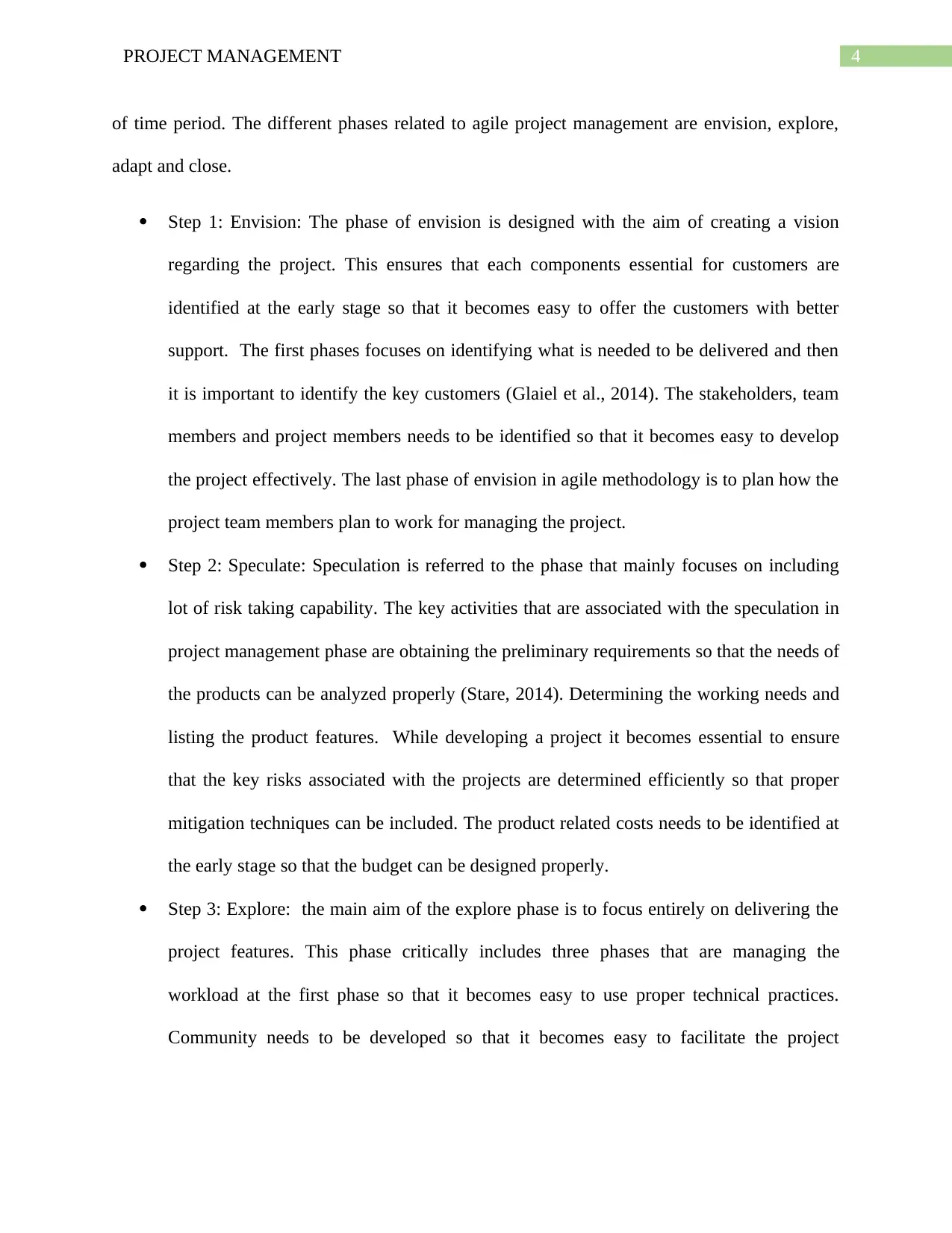
4PROJECT MANAGEMENT
of time period. The different phases related to agile project management are envision, explore,
adapt and close.
Step 1: Envision: The phase of envision is designed with the aim of creating a vision
regarding the project. This ensures that each components essential for customers are
identified at the early stage so that it becomes easy to offer the customers with better
support. The first phases focuses on identifying what is needed to be delivered and then
it is important to identify the key customers (Glaiel et al., 2014). The stakeholders, team
members and project members needs to be identified so that it becomes easy to develop
the project effectively. The last phase of envision in agile methodology is to plan how the
project team members plan to work for managing the project.
Step 2: Speculate: Speculation is referred to the phase that mainly focuses on including
lot of risk taking capability. The key activities that are associated with the speculation in
project management phase are obtaining the preliminary requirements so that the needs of
the products can be analyzed properly (Stare, 2014). Determining the working needs and
listing the product features. While developing a project it becomes essential to ensure
that the key risks associated with the projects are determined efficiently so that proper
mitigation techniques can be included. The product related costs needs to be identified at
the early stage so that the budget can be designed properly.
Step 3: Explore: the main aim of the explore phase is to focus entirely on delivering the
project features. This phase critically includes three phases that are managing the
workload at the first phase so that it becomes easy to use proper technical practices.
Community needs to be developed so that it becomes easy to facilitate the project
of time period. The different phases related to agile project management are envision, explore,
adapt and close.
Step 1: Envision: The phase of envision is designed with the aim of creating a vision
regarding the project. This ensures that each components essential for customers are
identified at the early stage so that it becomes easy to offer the customers with better
support. The first phases focuses on identifying what is needed to be delivered and then
it is important to identify the key customers (Glaiel et al., 2014). The stakeholders, team
members and project members needs to be identified so that it becomes easy to develop
the project effectively. The last phase of envision in agile methodology is to plan how the
project team members plan to work for managing the project.
Step 2: Speculate: Speculation is referred to the phase that mainly focuses on including
lot of risk taking capability. The key activities that are associated with the speculation in
project management phase are obtaining the preliminary requirements so that the needs of
the products can be analyzed properly (Stare, 2014). Determining the working needs and
listing the product features. While developing a project it becomes essential to ensure
that the key risks associated with the projects are determined efficiently so that proper
mitigation techniques can be included. The product related costs needs to be identified at
the early stage so that the budget can be designed properly.
Step 3: Explore: the main aim of the explore phase is to focus entirely on delivering the
project features. This phase critically includes three phases that are managing the
workload at the first phase so that it becomes easy to use proper technical practices.
Community needs to be developed so that it becomes easy to facilitate the project
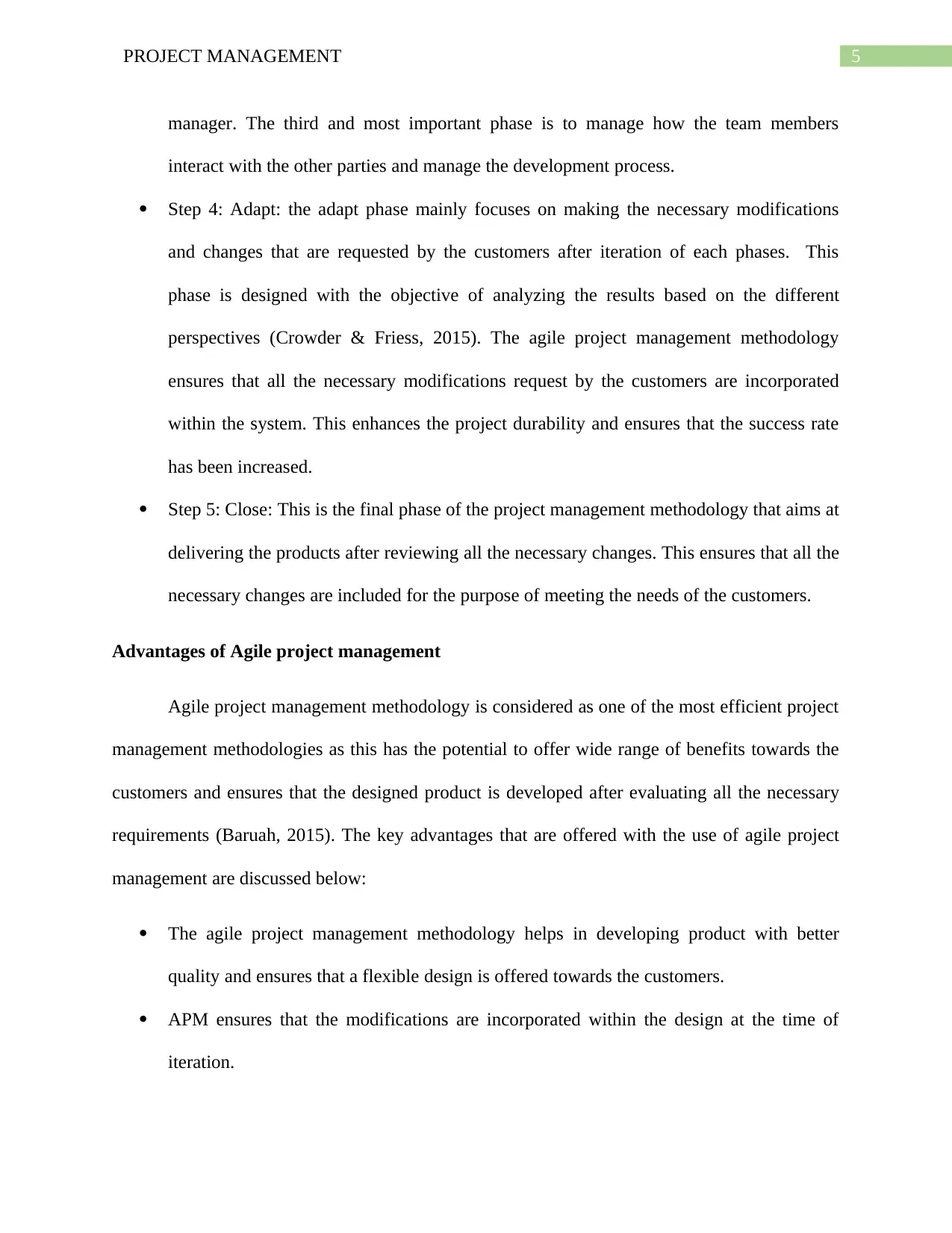
5PROJECT MANAGEMENT
manager. The third and most important phase is to manage how the team members
interact with the other parties and manage the development process.
Step 4: Adapt: the adapt phase mainly focuses on making the necessary modifications
and changes that are requested by the customers after iteration of each phases. This
phase is designed with the objective of analyzing the results based on the different
perspectives (Crowder & Friess, 2015). The agile project management methodology
ensures that all the necessary modifications request by the customers are incorporated
within the system. This enhances the project durability and ensures that the success rate
has been increased.
Step 5: Close: This is the final phase of the project management methodology that aims at
delivering the products after reviewing all the necessary changes. This ensures that all the
necessary changes are included for the purpose of meeting the needs of the customers.
Advantages of Agile project management
Agile project management methodology is considered as one of the most efficient project
management methodologies as this has the potential to offer wide range of benefits towards the
customers and ensures that the designed product is developed after evaluating all the necessary
requirements (Baruah, 2015). The key advantages that are offered with the use of agile project
management are discussed below:
The agile project management methodology helps in developing product with better
quality and ensures that a flexible design is offered towards the customers.
APM ensures that the modifications are incorporated within the design at the time of
iteration.
manager. The third and most important phase is to manage how the team members
interact with the other parties and manage the development process.
Step 4: Adapt: the adapt phase mainly focuses on making the necessary modifications
and changes that are requested by the customers after iteration of each phases. This
phase is designed with the objective of analyzing the results based on the different
perspectives (Crowder & Friess, 2015). The agile project management methodology
ensures that all the necessary modifications request by the customers are incorporated
within the system. This enhances the project durability and ensures that the success rate
has been increased.
Step 5: Close: This is the final phase of the project management methodology that aims at
delivering the products after reviewing all the necessary changes. This ensures that all the
necessary changes are included for the purpose of meeting the needs of the customers.
Advantages of Agile project management
Agile project management methodology is considered as one of the most efficient project
management methodologies as this has the potential to offer wide range of benefits towards the
customers and ensures that the designed product is developed after evaluating all the necessary
requirements (Baruah, 2015). The key advantages that are offered with the use of agile project
management are discussed below:
The agile project management methodology helps in developing product with better
quality and ensures that a flexible design is offered towards the customers.
APM ensures that the modifications are incorporated within the design at the time of
iteration.
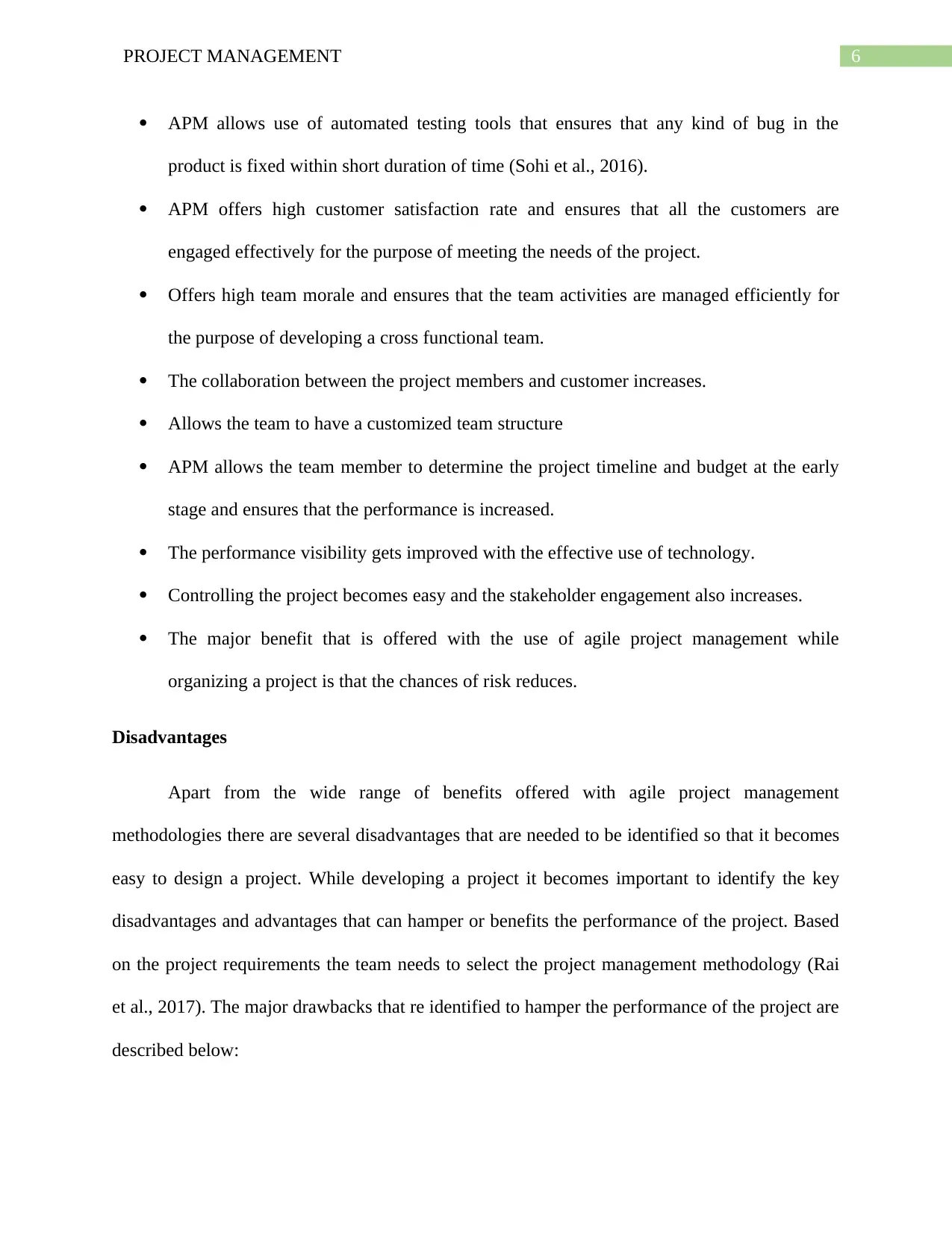
6PROJECT MANAGEMENT
APM allows use of automated testing tools that ensures that any kind of bug in the
product is fixed within short duration of time (Sohi et al., 2016).
APM offers high customer satisfaction rate and ensures that all the customers are
engaged effectively for the purpose of meeting the needs of the project.
Offers high team morale and ensures that the team activities are managed efficiently for
the purpose of developing a cross functional team.
The collaboration between the project members and customer increases.
Allows the team to have a customized team structure
APM allows the team member to determine the project timeline and budget at the early
stage and ensures that the performance is increased.
The performance visibility gets improved with the effective use of technology.
Controlling the project becomes easy and the stakeholder engagement also increases.
The major benefit that is offered with the use of agile project management while
organizing a project is that the chances of risk reduces.
Disadvantages
Apart from the wide range of benefits offered with agile project management
methodologies there are several disadvantages that are needed to be identified so that it becomes
easy to design a project. While developing a project it becomes important to identify the key
disadvantages and advantages that can hamper or benefits the performance of the project. Based
on the project requirements the team needs to select the project management methodology (Rai
et al., 2017). The major drawbacks that re identified to hamper the performance of the project are
described below:
APM allows use of automated testing tools that ensures that any kind of bug in the
product is fixed within short duration of time (Sohi et al., 2016).
APM offers high customer satisfaction rate and ensures that all the customers are
engaged effectively for the purpose of meeting the needs of the project.
Offers high team morale and ensures that the team activities are managed efficiently for
the purpose of developing a cross functional team.
The collaboration between the project members and customer increases.
Allows the team to have a customized team structure
APM allows the team member to determine the project timeline and budget at the early
stage and ensures that the performance is increased.
The performance visibility gets improved with the effective use of technology.
Controlling the project becomes easy and the stakeholder engagement also increases.
The major benefit that is offered with the use of agile project management while
organizing a project is that the chances of risk reduces.
Disadvantages
Apart from the wide range of benefits offered with agile project management
methodologies there are several disadvantages that are needed to be identified so that it becomes
easy to design a project. While developing a project it becomes important to identify the key
disadvantages and advantages that can hamper or benefits the performance of the project. Based
on the project requirements the team needs to select the project management methodology (Rai
et al., 2017). The major drawbacks that re identified to hamper the performance of the project are
described below:
Paraphrase This Document
Need a fresh take? Get an instant paraphrase of this document with our AI Paraphraser
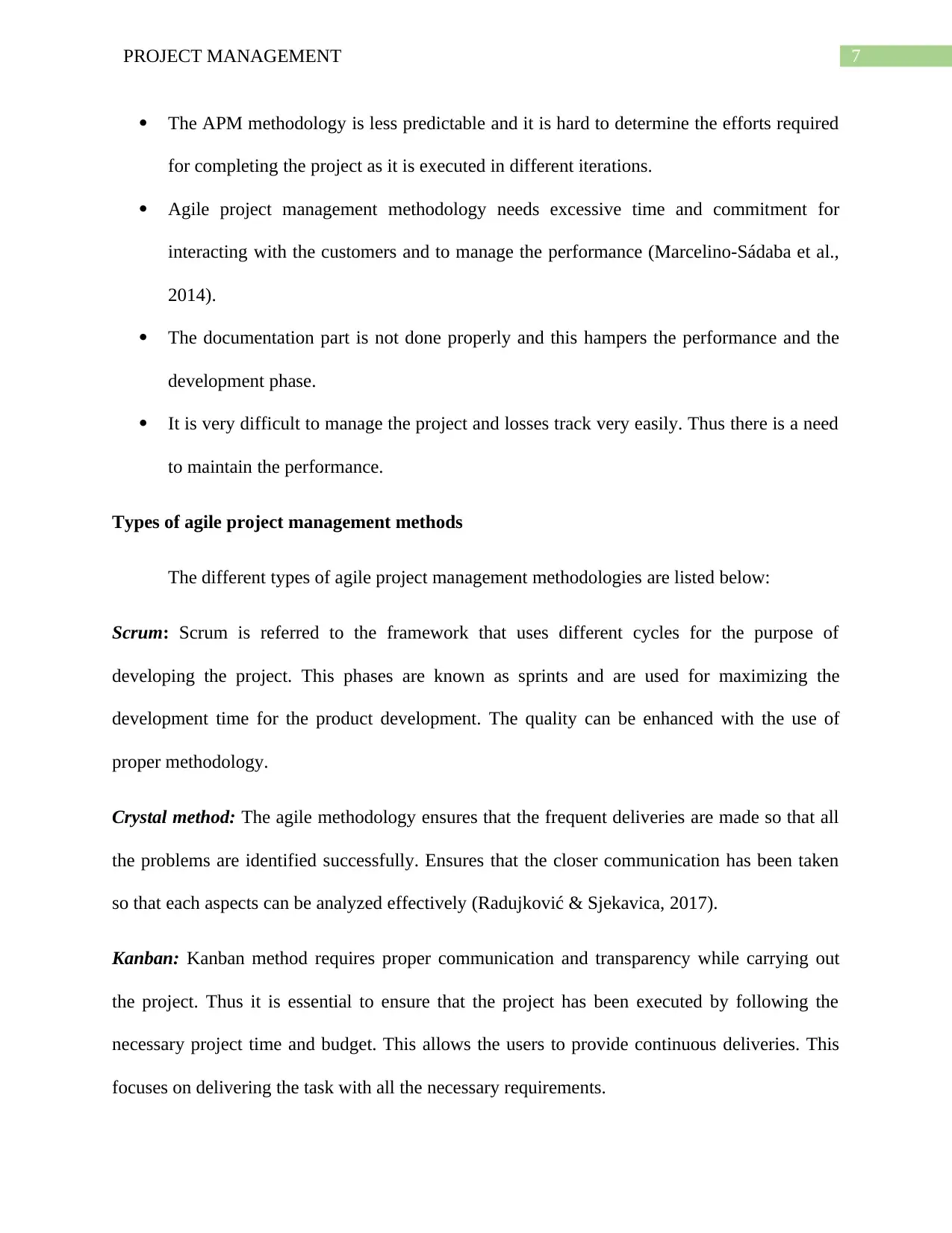
7PROJECT MANAGEMENT
The APM methodology is less predictable and it is hard to determine the efforts required
for completing the project as it is executed in different iterations.
Agile project management methodology needs excessive time and commitment for
interacting with the customers and to manage the performance (Marcelino-Sádaba et al.,
2014).
The documentation part is not done properly and this hampers the performance and the
development phase.
It is very difficult to manage the project and losses track very easily. Thus there is a need
to maintain the performance.
Types of agile project management methods
The different types of agile project management methodologies are listed below:
Scrum: Scrum is referred to the framework that uses different cycles for the purpose of
developing the project. This phases are known as sprints and are used for maximizing the
development time for the product development. The quality can be enhanced with the use of
proper methodology.
Crystal method: The agile methodology ensures that the frequent deliveries are made so that all
the problems are identified successfully. Ensures that the closer communication has been taken
so that each aspects can be analyzed effectively (Radujković & Sjekavica, 2017).
Kanban: Kanban method requires proper communication and transparency while carrying out
the project. Thus it is essential to ensure that the project has been executed by following the
necessary project time and budget. This allows the users to provide continuous deliveries. This
focuses on delivering the task with all the necessary requirements.
The APM methodology is less predictable and it is hard to determine the efforts required
for completing the project as it is executed in different iterations.
Agile project management methodology needs excessive time and commitment for
interacting with the customers and to manage the performance (Marcelino-Sádaba et al.,
2014).
The documentation part is not done properly and this hampers the performance and the
development phase.
It is very difficult to manage the project and losses track very easily. Thus there is a need
to maintain the performance.
Types of agile project management methods
The different types of agile project management methodologies are listed below:
Scrum: Scrum is referred to the framework that uses different cycles for the purpose of
developing the project. This phases are known as sprints and are used for maximizing the
development time for the product development. The quality can be enhanced with the use of
proper methodology.
Crystal method: The agile methodology ensures that the frequent deliveries are made so that all
the problems are identified successfully. Ensures that the closer communication has been taken
so that each aspects can be analyzed effectively (Radujković & Sjekavica, 2017).
Kanban: Kanban method requires proper communication and transparency while carrying out
the project. Thus it is essential to ensure that the project has been executed by following the
necessary project time and budget. This allows the users to provide continuous deliveries. This
focuses on delivering the task with all the necessary requirements.
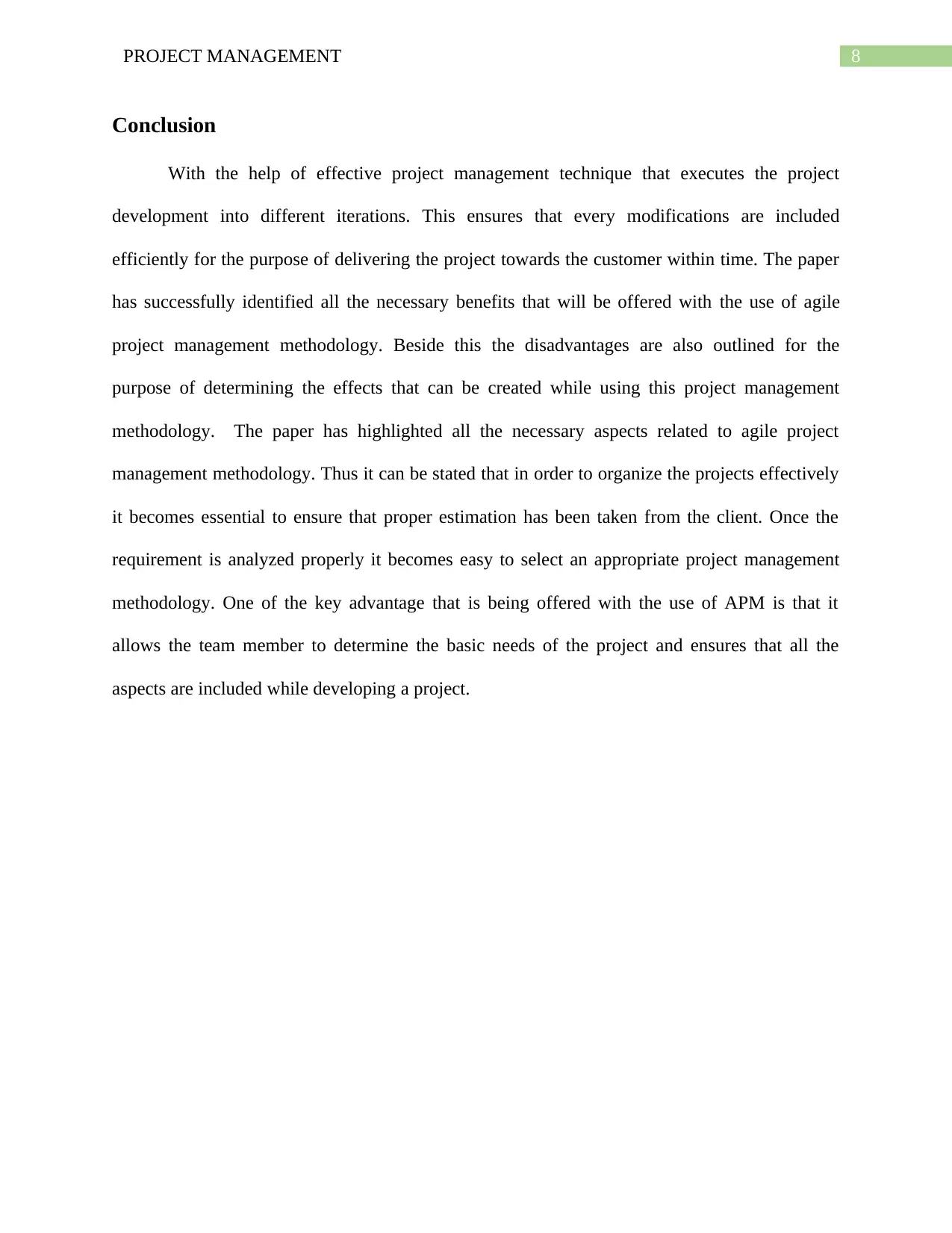
8PROJECT MANAGEMENT
Conclusion
With the help of effective project management technique that executes the project
development into different iterations. This ensures that every modifications are included
efficiently for the purpose of delivering the project towards the customer within time. The paper
has successfully identified all the necessary benefits that will be offered with the use of agile
project management methodology. Beside this the disadvantages are also outlined for the
purpose of determining the effects that can be created while using this project management
methodology. The paper has highlighted all the necessary aspects related to agile project
management methodology. Thus it can be stated that in order to organize the projects effectively
it becomes essential to ensure that proper estimation has been taken from the client. Once the
requirement is analyzed properly it becomes easy to select an appropriate project management
methodology. One of the key advantage that is being offered with the use of APM is that it
allows the team member to determine the basic needs of the project and ensures that all the
aspects are included while developing a project.
Conclusion
With the help of effective project management technique that executes the project
development into different iterations. This ensures that every modifications are included
efficiently for the purpose of delivering the project towards the customer within time. The paper
has successfully identified all the necessary benefits that will be offered with the use of agile
project management methodology. Beside this the disadvantages are also outlined for the
purpose of determining the effects that can be created while using this project management
methodology. The paper has highlighted all the necessary aspects related to agile project
management methodology. Thus it can be stated that in order to organize the projects effectively
it becomes essential to ensure that proper estimation has been taken from the client. Once the
requirement is analyzed properly it becomes easy to select an appropriate project management
methodology. One of the key advantage that is being offered with the use of APM is that it
allows the team member to determine the basic needs of the project and ensures that all the
aspects are included while developing a project.
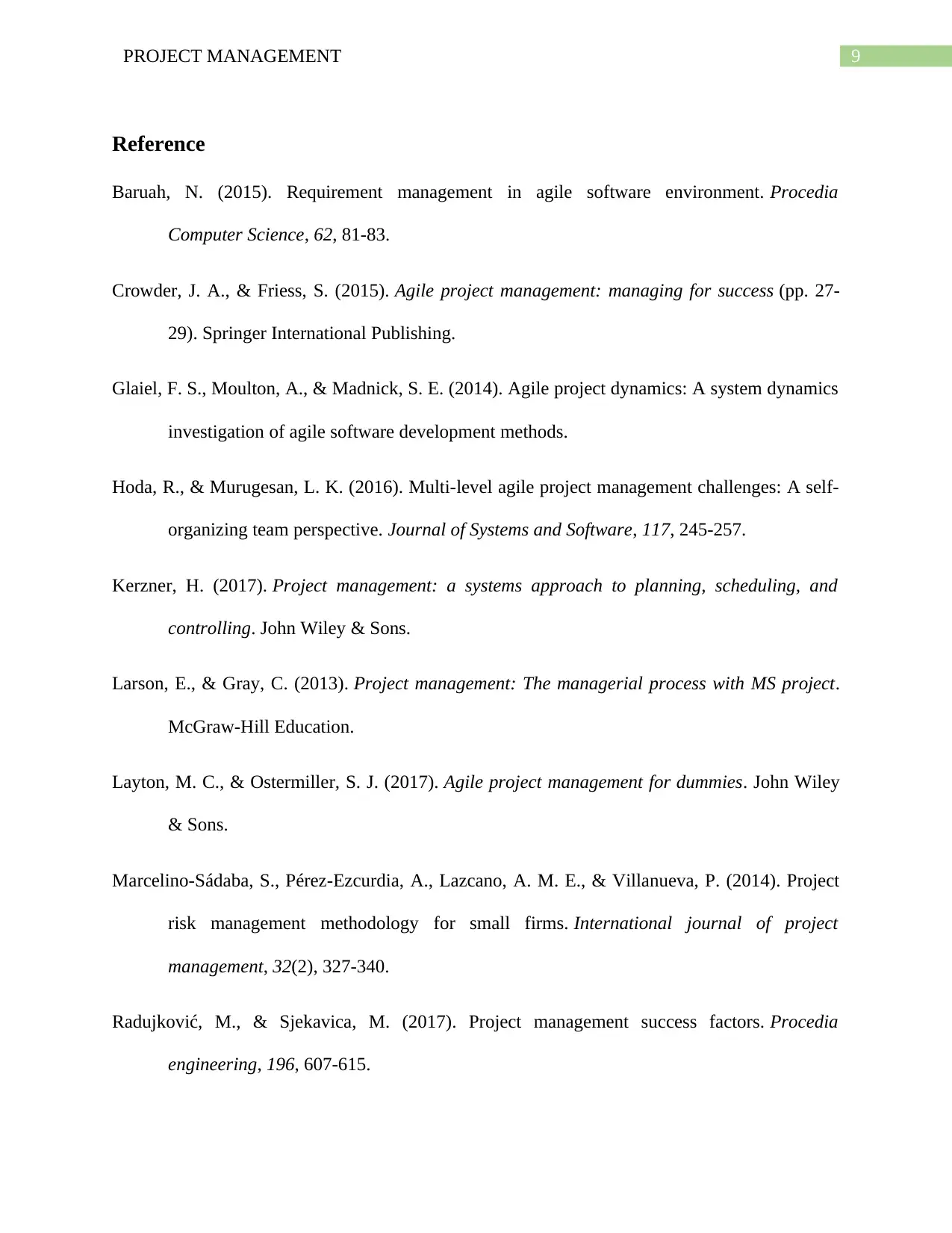
9PROJECT MANAGEMENT
Reference
Baruah, N. (2015). Requirement management in agile software environment. Procedia
Computer Science, 62, 81-83.
Crowder, J. A., & Friess, S. (2015). Agile project management: managing for success (pp. 27-
29). Springer International Publishing.
Glaiel, F. S., Moulton, A., & Madnick, S. E. (2014). Agile project dynamics: A system dynamics
investigation of agile software development methods.
Hoda, R., & Murugesan, L. K. (2016). Multi-level agile project management challenges: A self-
organizing team perspective. Journal of Systems and Software, 117, 245-257.
Kerzner, H. (2017). Project management: a systems approach to planning, scheduling, and
controlling. John Wiley & Sons.
Larson, E., & Gray, C. (2013). Project management: The managerial process with MS project.
McGraw-Hill Education.
Layton, M. C., & Ostermiller, S. J. (2017). Agile project management for dummies. John Wiley
& Sons.
Marcelino-Sádaba, S., Pérez-Ezcurdia, A., Lazcano, A. M. E., & Villanueva, P. (2014). Project
risk management methodology for small firms. International journal of project
management, 32(2), 327-340.
Radujković, M., & Sjekavica, M. (2017). Project management success factors. Procedia
engineering, 196, 607-615.
Reference
Baruah, N. (2015). Requirement management in agile software environment. Procedia
Computer Science, 62, 81-83.
Crowder, J. A., & Friess, S. (2015). Agile project management: managing for success (pp. 27-
29). Springer International Publishing.
Glaiel, F. S., Moulton, A., & Madnick, S. E. (2014). Agile project dynamics: A system dynamics
investigation of agile software development methods.
Hoda, R., & Murugesan, L. K. (2016). Multi-level agile project management challenges: A self-
organizing team perspective. Journal of Systems and Software, 117, 245-257.
Kerzner, H. (2017). Project management: a systems approach to planning, scheduling, and
controlling. John Wiley & Sons.
Larson, E., & Gray, C. (2013). Project management: The managerial process with MS project.
McGraw-Hill Education.
Layton, M. C., & Ostermiller, S. J. (2017). Agile project management for dummies. John Wiley
& Sons.
Marcelino-Sádaba, S., Pérez-Ezcurdia, A., Lazcano, A. M. E., & Villanueva, P. (2014). Project
risk management methodology for small firms. International journal of project
management, 32(2), 327-340.
Radujković, M., & Sjekavica, M. (2017). Project management success factors. Procedia
engineering, 196, 607-615.
Secure Best Marks with AI Grader
Need help grading? Try our AI Grader for instant feedback on your assignments.
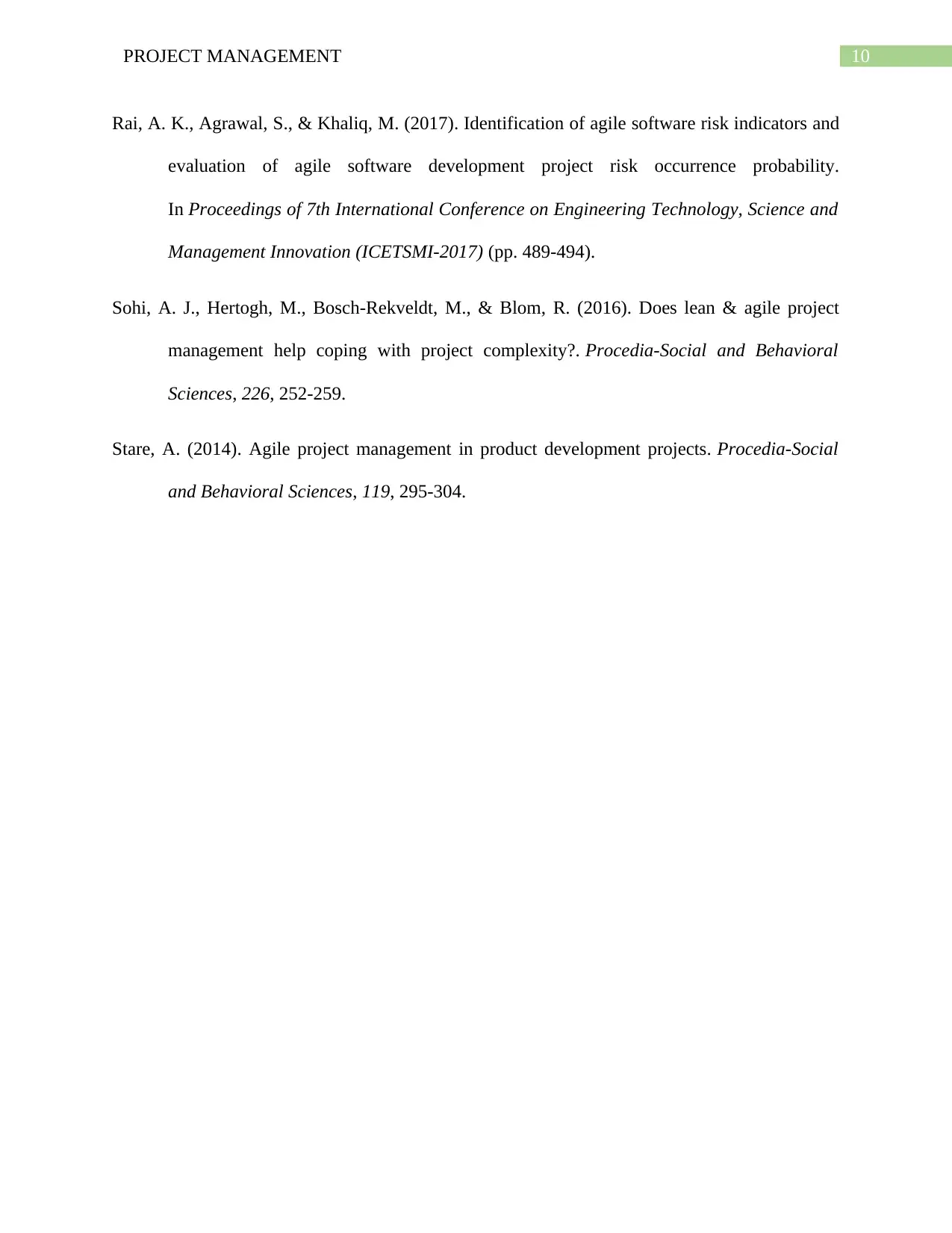
10PROJECT MANAGEMENT
Rai, A. K., Agrawal, S., & Khaliq, M. (2017). Identification of agile software risk indicators and
evaluation of agile software development project risk occurrence probability.
In Proceedings of 7th International Conference on Engineering Technology, Science and
Management Innovation (ICETSMI-2017) (pp. 489-494).
Sohi, A. J., Hertogh, M., Bosch-Rekveldt, M., & Blom, R. (2016). Does lean & agile project
management help coping with project complexity?. Procedia-Social and Behavioral
Sciences, 226, 252-259.
Stare, A. (2014). Agile project management in product development projects. Procedia-Social
and Behavioral Sciences, 119, 295-304.
Rai, A. K., Agrawal, S., & Khaliq, M. (2017). Identification of agile software risk indicators and
evaluation of agile software development project risk occurrence probability.
In Proceedings of 7th International Conference on Engineering Technology, Science and
Management Innovation (ICETSMI-2017) (pp. 489-494).
Sohi, A. J., Hertogh, M., Bosch-Rekveldt, M., & Blom, R. (2016). Does lean & agile project
management help coping with project complexity?. Procedia-Social and Behavioral
Sciences, 226, 252-259.
Stare, A. (2014). Agile project management in product development projects. Procedia-Social
and Behavioral Sciences, 119, 295-304.
1 out of 11
Related Documents
Your All-in-One AI-Powered Toolkit for Academic Success.
+13062052269
info@desklib.com
Available 24*7 on WhatsApp / Email
![[object Object]](/_next/static/media/star-bottom.7253800d.svg)
Unlock your academic potential
© 2024 | Zucol Services PVT LTD | All rights reserved.




